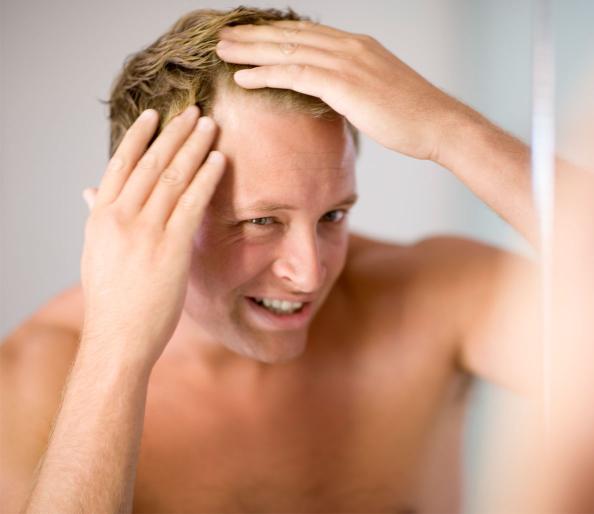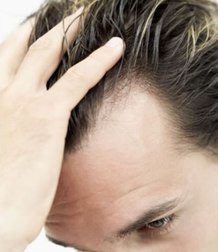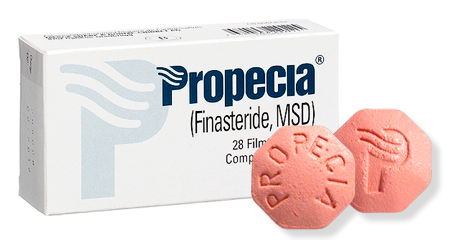YOUR DIABOLICAL FOLLICLES: TREATING MALE PATTERN BALDNESS |
| None of it worked, of course. "There are as many desperate home remedies as there are receding hairlines," Kobren says. "If any of them really worked, it would be prime-time, head-line news. You really think some guy in his basement in Wisconsin has the cure to hair loss? You want to believe it, but come on." Of the seemingly infinite treatment options to slow or reverse baldness, there are only three that are widely accepted as valid. But before you learn how to keep your hair, you need to understand why you're losing it. |
Male Pattern Baldness
Men have been suffering from androgenetic alopecia, otherwise known as male pattern baldness, since before the first coming of Christ. Julius Caesar was memorialized many times in stone with what was left of his hair combed forward, and a signature wreath covering his pate. Receding hairlines and bald spots plague men of every race, creed, and status. But why?
According to Bernard Arocha, M.D., president and owner of Arocha Hair Restoration, MPB occurs when a man has a genetic predisposition to sensitivity to the potent androgenic hormone called dihydrotestosterone (DHT). In most men, about 5 percent of their serum testosterone is converted to DHT by an enzyme called 5-alpha reductase. To those with the inherited sensitivity, DHT acts like a toxin on the hair follicles along the temples and mid-anterior scalp, undermining the absorption of nutrients and causing progressive miniaturization, which is when the growth phase of the follicles is shortened.
"There are 100,000 to 150,000 follicles on a full scalp," Arocha says, "all of which follow growth and rest phases. The growing (anagen) phase usually lasts about three to six years, during which time each hair matures in thickness and color. The resting (telogen) phase, when a hair ends its growth phase and falls out, lasts about 90 days. At any given time, only about 10 percent of follicles are in the resting phase, so normal hair loss is not noticeable." But for men with DHT sensitivity, over time, the growth phases of the follicles become so short that they grow only very fine, almost colorless hair (vellus hairs) until the miniaturization is complete and they produce none at all. Interestingly, the follicles around the ears and at the back of the head aren't affected by DHT, and MPB sufferers are left with a horseshoe pattern of hair.
More recently, researchers from the Perelman School of Medicine at the University of Pennsylvania have identified an abnormal amount of a lipid called prostaglandin D2 (PGD2) in the bald scalp of men with MPB. While the new findings haven't yielded any treatment, "it's a new piece of the puzzle," Kobren says. "We know that DHT is a major culprit, but maybe it's not only DHT that causes MPB." Scientists continue to look for other genetic and environmental factors to explain--and treat--baldness. Several groups are now looking at the relationship between the microscopic receptors that bind to Vitamin D in skin cells. "There's always interesting research being conducted," Kobren says. "It's always disappointing if the findings are ultimately inconclusive--but we keep hoping for a breakthrough."
For reasons scientists don't fully understand, sensitive follicles must be exposed to DHT for a prolonged period of time before the miniaturization process is complete. But what they have learned is that taking a drug that inhibits the binding of 5-alpha-reductase on testosterone can reduce the levels of DHT and thus slow or even stop the miniaturization process. There is such a drug and it's called finasteride (sold as Propecia), the first of the three aforementioned treatment options.
"Finasteride blocks 70% of the conversion of testosterone to DHT," Arocha says. "There are some reported sexual side effects such as erectile dysfunction, problems with ejaculation, and depression, so you should speak to your doctor before taking it. However, there have been very good results for stopping hair loss and even regrowing hair." According to the product website, most men in the clinical studies see results within three to 12 months. If no improvement is seen after that time, further treatment is unlikely to be of benefit. Also, if you quit using the product, you will likely lose the hair you retained or regrew while under the treatment.
Even better than finasteride alone is when it's used in conjunction with the second treatment: the topical solution minoxidil (sold as Rogaine). "Minoxidil is like a follicle fertilizer," Kobren says. It acts as a vasodilator that keeps hair in the anagen phase longer and can increase the diameter of those downy vellus hairs, but it doesn't get to the root cause of hair loss. "Only 35% of men are able to slow or stop hair loss with minoxidil alone, and only 10% see regrowth, usually in the crown area, and like the finasteride, the benefits stop if you stop using the product," Arocha says. "But using both together over time yields the best nonsurgical results possible."
Which brings us to the final treatment option, and one that both Arocha and Kobren say should be the last resort: hair transplantation. "I sat in a transplant doctor's office in 1988, and he told me that if I were his son, he'd say try a few grafts. That was back when they used to put in 4mm plugs. I was thinning, sure, but I was 22 years old. If I'd let him put plugs in me then, I'd have ended up looking like a hairbrush with bristles of 30 hairs each lined up in rows and columns starting at my hairline. It would have ruined my life."
Fortunately, the technology has dramatically improved and now doctors like Arocha can harvest individual follicular units--a natural grouping of one to five hairs--from permanent donor sites above the ear and at the back of the head, and move them to the thinning or bald areas. Arocha, who also started to lose his hair at a young age, approaches each scalp as though it were a canvas: the harvested follicles the paint, and he, the artist. "Think of a forest," he says. "At the edge, you see shrubbery first, then a few trees, then groups of trees that grow thicker the further you go. I observe that same principle, carefully placing the donor follicles in a progression. There must be artistry in the technique, or the results can be disastrous."
The average cost for a transplant is $7,000-$15,000 or more. "Buyer beware," Arocha says. "Do careful research on the transplant surgeon and his technique. Know what's involved and what's at stake. And realize that the result depends largely on the amount of "paint" a surgeon has to work with." But when it works, it really works. "I can't tell you how many men come back and tell me that their hair restoration has given them back not just their hair but also their lives. That's proof that it's worth it."
Source: menshealth.com
www.masaakii.com
Author
By Masaakii
Archives
May 2024
November 2023
October 2023
August 2021
May 2021
January 2021
November 2020
June 2020
November 2019
January 2019
November 2018
September 2018
July 2018
April 2018
March 2018
January 2018
December 2017
November 2017
October 2017
September 2017
August 2017
June 2017
May 2017
April 2017
March 2017
February 2017
January 2017
December 2016
November 2016
October 2016
September 2016
August 2016
July 2016
June 2016
May 2016
April 2016
March 2016
February 2016
January 2016
December 2015
November 2015
Categories
All
Balding
Coffee
Dry Hair
Greasy Hair
Grow Hair Naturally
Hairfiber
Hair Fiber Canada
Hair Fibers
Hair Growth
Hair Growth And Hormones
Hair Loss
Hair Loss Breakthrough
Hairloss Breaktthrough
Hair Loss Canada
Hair Loss Hard Water
Hair Loss Treatment
Hair Stem
Hair Thinning
Headache
How To Grow Hair
Male Bald Pattern
Migraine
New Gene For Hair Loss
Shiseido And Replicel
Stem Cell
Stress And Hair Loss
Woman Hair Loss
Women Hair Loss



 RSS Feed
RSS Feed